TORONTO (Jan. 8) — Though it ended with a stinker on Monday night at Scotiabank Arena, the Maple Leafs undoubtedly saved their season with the 15–4–1 eruption (Nov. 23–Jan. 4) under new coach Sheldon Keefe. It ranked among the best 20–game segments in franchise history and lifted the club from the morass in the Eastern Conference. Heading into a home encounter tonight, against Winnipeg, the Leafs are third in the Atlantic Division with 53 points, one point behind second–place Tampa Bay (both clubs 8–1–1 in their past 10 games). The first three teams in each division make the playoffs. Boston sits atop the Atlantic with 61 points.
While at work on Tuesday afternoon in the parking lot at Benjamin’s, a man named Dougall Currie could barely be contained. “Doogs”, as I call him, is employed by the limousine company that drives families to and from our chapel. A big, beefy guy with a thick, grey beard, he’s a fanatic Leafs supporter. “Love it… just love it,” Doogs said about the renaissance under Keefe. “Give me 7–6 or 6–5 every night. I’ll take it. As long as they win. It’s so exciting to watch.” Dougall was bang–on about the entertainment value the Leafs are providing. Fans spending triple figures to attend games are watching one of the fastest and most–creative teams in modern franchise history. Given that Doogs is such a fine fella, I didn’t want to spoil his mood. But, I couldn’t help reminding him that the Leafs are playing a style that isn’t likely to prevail during the two–month Stanley Cup slog, when out–gunning the opposition is less–critical than guarding the defensive zone… with some belligerence. The Leafs possess neither trait; they rely on acrobatic goaltending to accrue points.
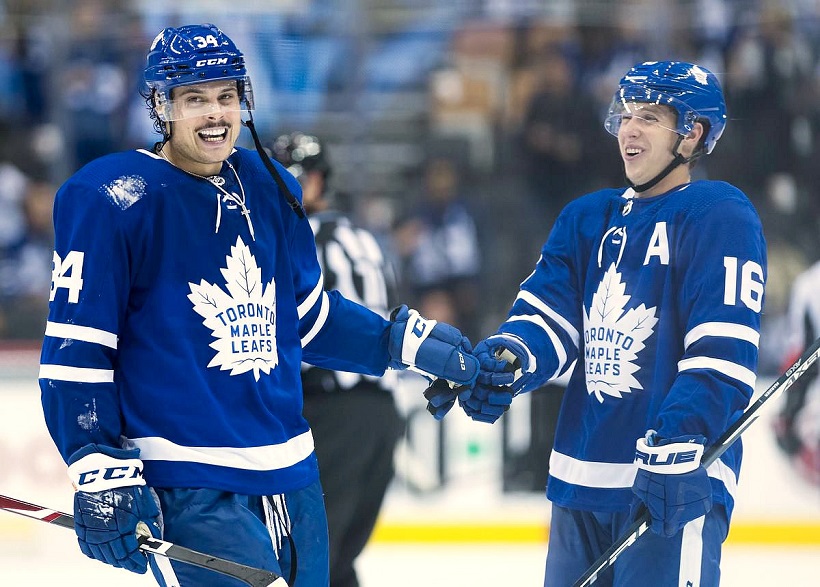
AUSTON MATTHEWS (LEFT) AND MITCH MARNER ARE SPINNING THEIR ARTISTRY FOR THE LEAFS. TORONTO STAR PHOTO
“Yeah, but you gotta make the playoffs, first,” countered Doogs, correctly. “And, this is the way teams in the East generally play — with speed and moving the puck. The game is a little heavier out west.” As Dougall implied, the playoffs were becoming a pipe–dream while the Leafs scuffled under Mike Babcock: 9–10–4 until he was fired, Nov. 20. Such a middling start required a lengthy string of prosperity, which immediately transpired under Keefe; the Maple Leafs gobbling up 34 of 40 available points in his first 20 games behind the bench. Prior to the puck–drop in October, I wrote, in this space, that the Leafs are “exquisitely built” for the 82–game regular season; not–so–much for the two–month grind that follows. Of course, I looked like an idiot until late–November. But, my concern hasn’t been altered by the club’s recent power–move. The Leafs do not perform with nearly enough poise and tenacity on their side of the center red–line. Particularly, within range of their goal. In my opinion, such a team cannot be counted upon during May and June.
Another concern relates to my infinite view that a legitimate, Stanley Cup contender requires at least one Norris Trophy threat. That alone does not guarantee success — the Leafs had such a player last year with Morgan Rielly — but a team lacking the commodity almost–never raises the silver mug. Even though Toronto is tied with Colorado for second–most goals scored in the NHL (159, just two behind Washington), no blue–liner is even remotely in the Norris conversation. After compiling 72 points last season, the most for any Leafs defenseman not named Borje Salming or Ian Turnbull, Rielly has tailed off to 25 in 44 games; on pace for 48. Following a thoroughly miserable start under Babcock, Tyson Barrie has improved while playing for Keefe, but is hardly the presence many were anticipating after the summer trade with Colorado for Nazem Kadri (of course, practically every Toronto acquisition is hyped as a miracle–worker; Barrie was no exception). The remainder of the Leafs blue line is comprised of journeymen sloggers: Jake Muzzin, Travis Dermott, Justin Holl, Cody Ceci and (sigh) Martin Marincin. Adequate, yes, but not of Stanley Cup caliber.
This should not minimize, in any way, the remarkable turnaround under Keefe — exactly what the doctor ordered for the Blue and White. But, neither does it invalidate that the Leafs are too erratic, defensively, to prevail through four rounds of the Stanley Cup tournament. Some in the media have been celebrating the Maple Leafs for their mild comportment. But, the absence of size and snarl will become an increasing factor in May and June. Again, the regular season and playoffs should not be confused as one and the same.
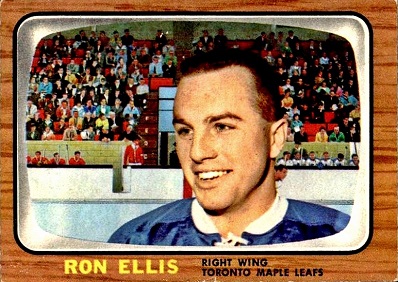
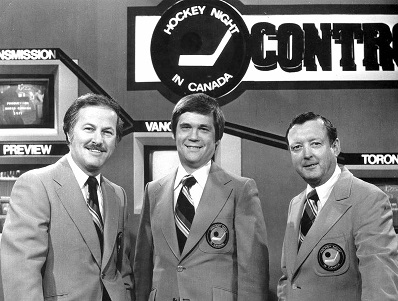
DIAMOND JUBILEE: Happy 75th birthday to hockey legends Ron Ellis (left) and Dave Hodge (in middle, right, flanked by Brian MacFarlane and Bill Hewitt) — born on this day in 1945.
FROM MY COLLECTION — Part 1
My website is now in its 10th year and still heavy on sports memorabilia. Regular visitors know that I have a large collection of books, magazines, game–programs and media guides — primarily from the National Hockey League, but also including football (CFL and NFL), baseball and basketball.
In the first of a series, I share some items with you:
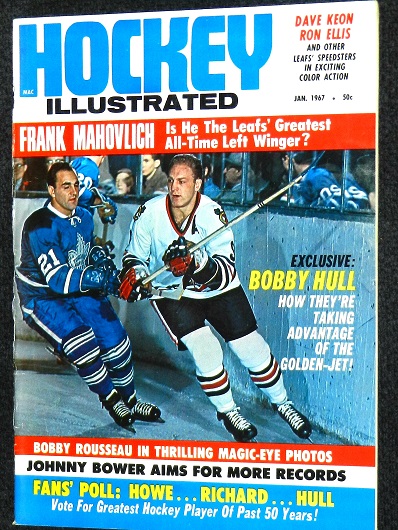
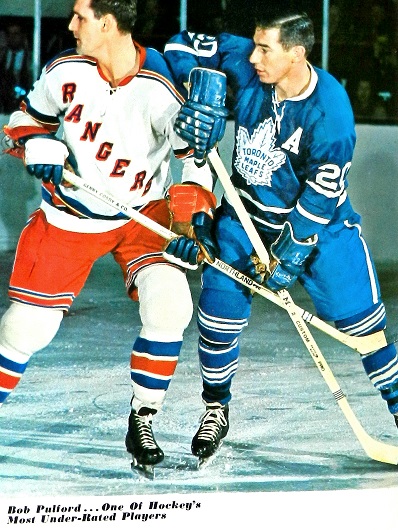
The January 1967 issue of Hockey Illustrated Magazine (top–left) showed Bobby Hull of Chicago being watched closely by Toronto defenseman Bob Baun at Maple Leaf Gardens. The Leafs and Black Hawks would meet in the ’67 Stanley Cup semifinals. Published in the 1960’s, 70’s and 80’s, Hockey Illustrated featured a four–page center–spread of color photos. Among the images in this edition was from a New York at Toronto game (top–right): Wayne Hillman of the Rangers checking Bob Pulford of the Leafs.
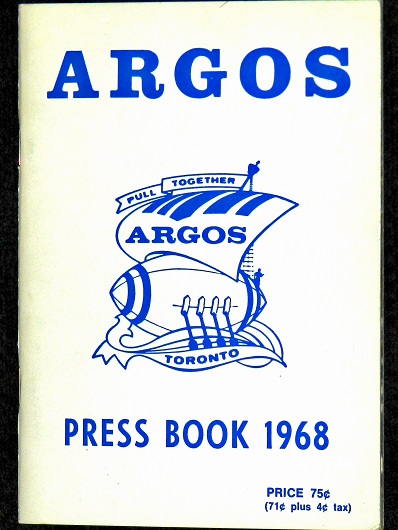
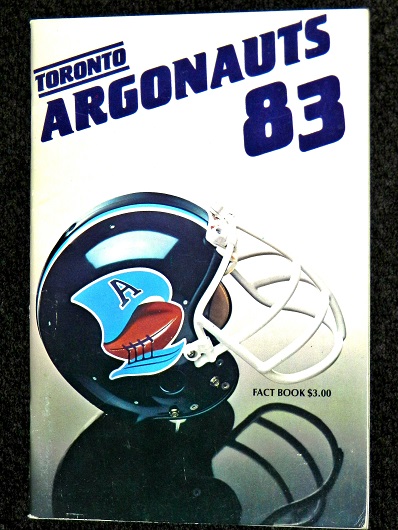
Before the arrival, in 1977, of the Blue Jays, Toronto had two professional sports teams: the Maple Leafs and the Canadian Football League Argonauts — commensurate in popularity among local sports fans. After years of struggling in the 1960’s, the Argos of 1968 (media guide, top–left) began to fill the 33,135–seat CNE Stadium. Their coach, Leo Cahill (July 30, 1928–Feb. 15, 2018) became the most popular and quotable sports figure in town. When the Argos finally ended a 31–year Grey Cup drought in 1983 (top–right) by edging the B.C. Lions 18–17 in Vancouver, the city lost its collective mind. More than 60,000 people jammed Bay Street as second–year coach Bob O’Billovich and the Argos paraded northward from Union Station to City Hall.
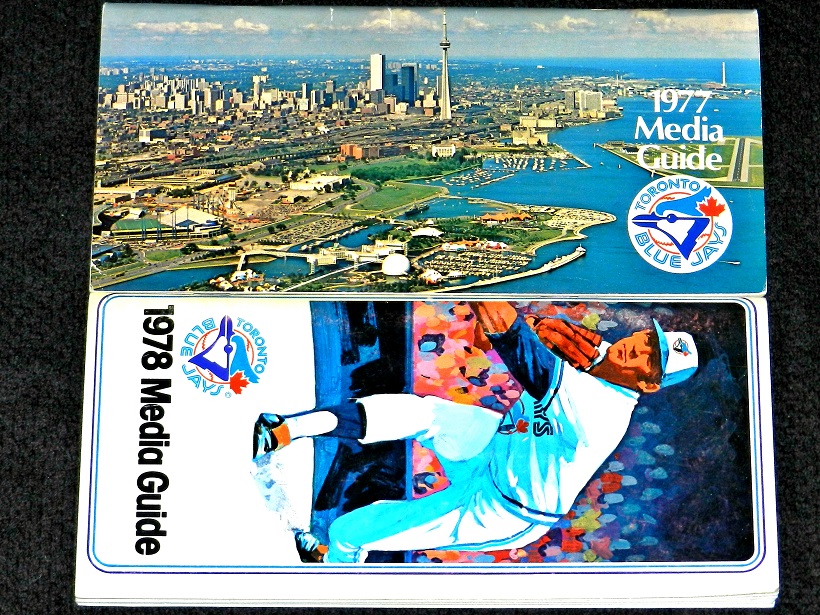
The first two Blue Jays media guides: 1977 and 1978. On the cover of the inaugural edition was an aerial photo of downtown Toronto, uncluttered by the lakefront condominiums of today. The SkyDome (now Rogers Centre) had yet to be built at the western base of the C.N. Tower. Exhibition Stadium, home of the Blue Jays from 1977–89, stood at lower–left, across from Ontario Place and Lake Ontario.
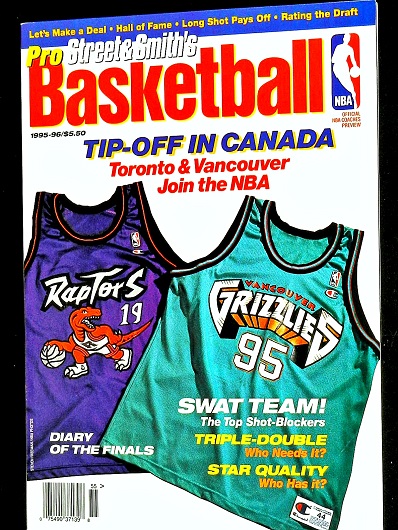
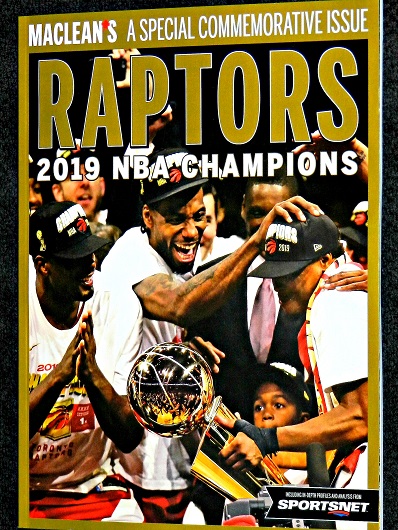
Original jerseys of the Toronto Raptors and Vancouver Grizzlies graced the Canadian edition of Street & Smith’s Pro Basketball magazine (top–left) in the autumn of 1995. The Vancouver club moved to Memphis in 2001–02, leaving the Raptors as the lone NBA entry north of the border. Just 23 years later, Kawhi Leonard and the Raptors defeated Golden State to win their first championship. The issue of MacLean’s Magazine, top–right, was among several commemorative volumes released in Canada and the United States.
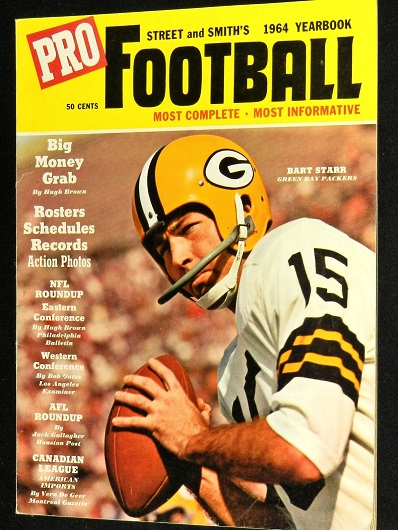
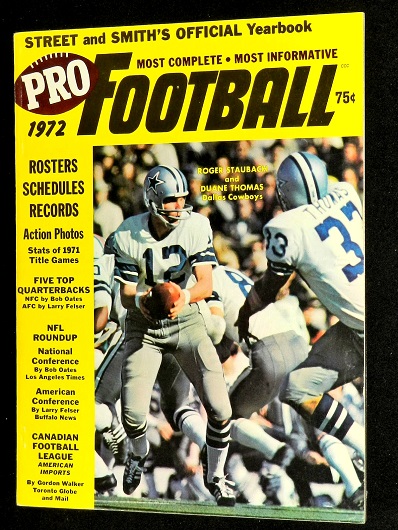
In the 60’s, 70’s and 80’s, no NFL season was complete without Street & Smith’s Pro Football magazine. Among more than 30–such items in my collection is the 1964 issue (top–left) with Green Bay Packers legend Bart Starr on the cover. Roger Staubach of the Dallas Cowboys made the cover (top–right) in 1972. These annual publications included predictions for the NFL and CFL seasons.
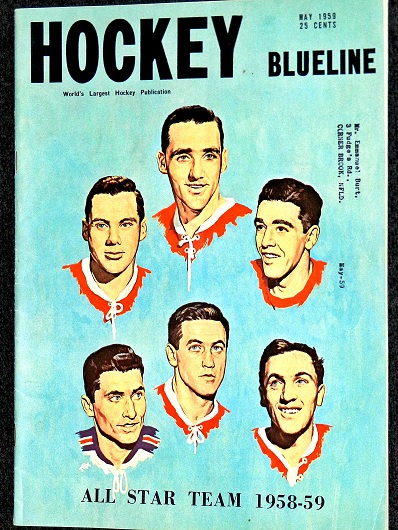
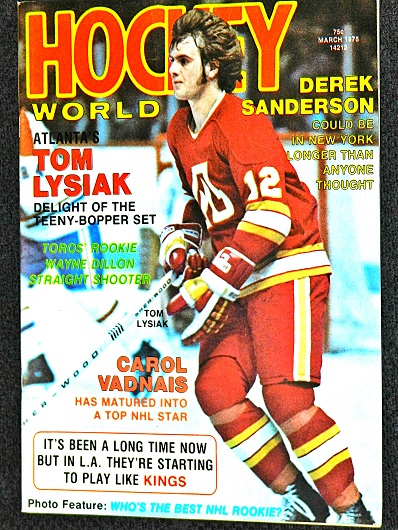
Beginning in November 1954, the Blueline Publishing Co. in Montreal produced 41 monthly issues of Blueline Hockey magazine. Eight per season, through 1958–59. The final edition (top–left) came out in May 1959 and featured painted images of the NHL’s First All–Star team. Top (left–to–right): defenseman Tom Johnson (Montreal); goalie Jacques Plante (Montreal); defenseman Marcel Pronovost (Detroit). Bottom (left–to–right): left–wing Andy Bathgate (New York); center Jean Beliveau (Montreal); right–wing Dickie Moore (Montreal). W.C.C. Publishing in Montreal, which put out The Hockey News each week, started Hockey World magazine in 1965–66 and continued through the 1970’s. The late Tom Lysiak (Apr. 22, 1953–May 30, 2016) of the Atlanta (now Calgary) Flames graced the cover of the March 1975 edition (top–right).
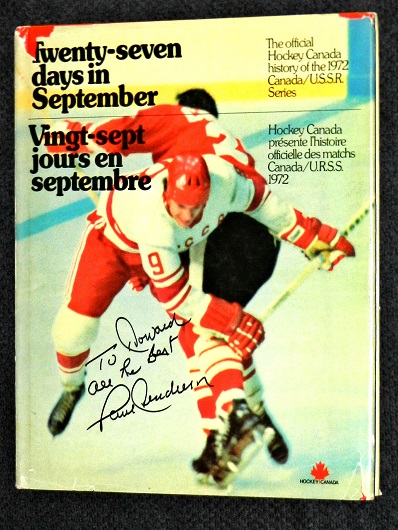
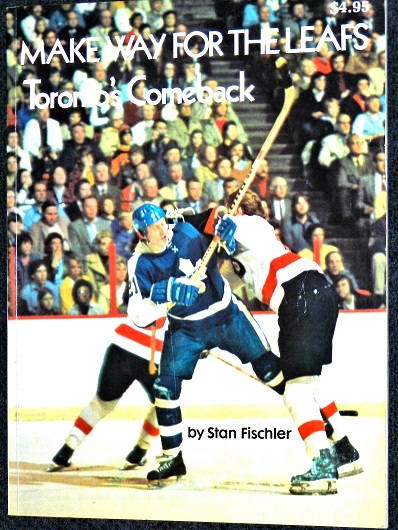
The forerunner to all the great international hockey of the past 47 years was the eight–game Canada–Russia quarrel in September 1972, famously won in the final minute of Game 8 by Canadian winger Paul Henderson. In early–1973, Hockey Canada published a 130–page commemorative book (top–left) on the series. Henderson signed the cover to me on his 74th birthday (Jan. 28, 2017). In the mid–70’s, Prentice Hall of Canada Ltd. published half–a–dozen books on NHL teams, including the Boston Bruins, Minnesota North Stars, Philadelphia Flyers and Toronto Maple Leafs — all written by the famed New York author, Stan Fischler. The Leafs edition (top–right) came out in early–1975 and detailed the team’s recovery from the 1972–73 season, when defections to the World Hockey Association (Bernie Parent, Jim Dorey, Brad Selwood, Rick Ley, Jim Harrison, Guy Trottier) resulted in the franchise’s worst record to that time in a minimum 70–game schedule (27–40–10 for 64 points). Hall–of–Fame defenseman Borje Salming was on the cover.
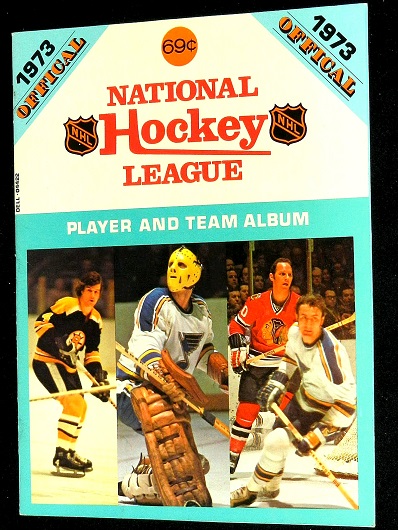
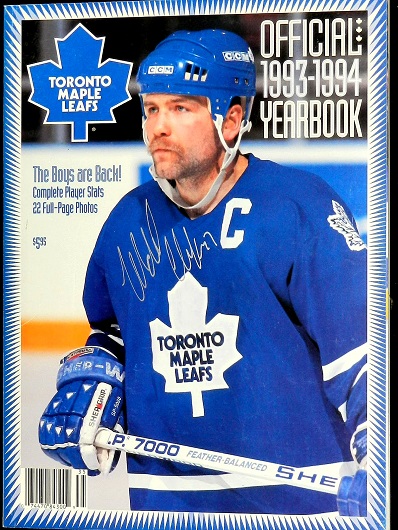
An oddly–priced sticker album (top–left) produced by the National Hockey League during the 1972–73 season. Even more odd? Star players Bobby Orr and Dennis Hull on the cover, flanking obscure St. Louis goalie Jacques Caron. The Maple Leafs were indeed “back” during the 1992–93 season — Doug Gilmour establishing team records for assists (95) and points (127) to spark a 32–point improvement from the previous year, under coach Pat Burns. But, it was fan favorite Wendel Clark on the cover (top–right) of the Leafs 1993–94 yearbook… which he signed to me in silver ink.
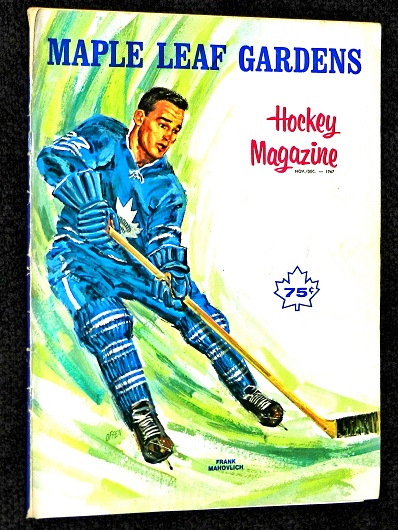
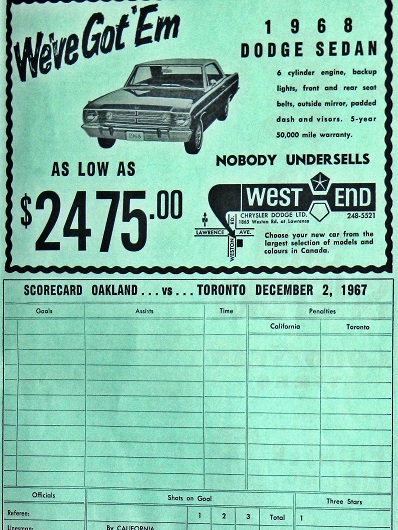
Toward the end of November, 1967, the expansion California Seals — drawing poorly for home games at the Oakland Coliseum–Arena — changed their name to the Oakland Seals, hoping to attract more fans from the east side of San Francisco Bay. The Seals came to Toronto for the second time on Dec. 2, 1967. The Maple Leaf Gardens program–cover (top–left) featured a water–color of Frank Mahovlich, while the Dodge advertisement atop the scorecard (top–right) showed the cost of a car more than 52 years ago. The line–ups are below. The Leafs blanked Oakland 3–0, Johnny Bower stopping 38 shots for the shutout. Mike Walton scored in the second period; Ron Ellis, twice, in the third on Charlie Hodge, who faced 49 Toronto shots. The referee was Vern Buffey. The linesmen were Neil Armstrong and Ron Ego.
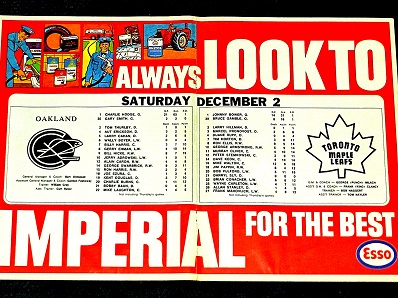
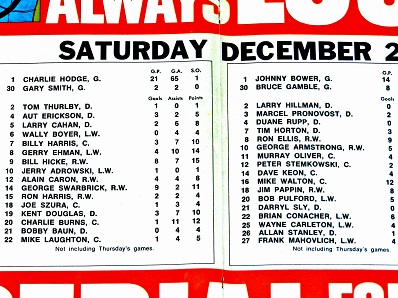
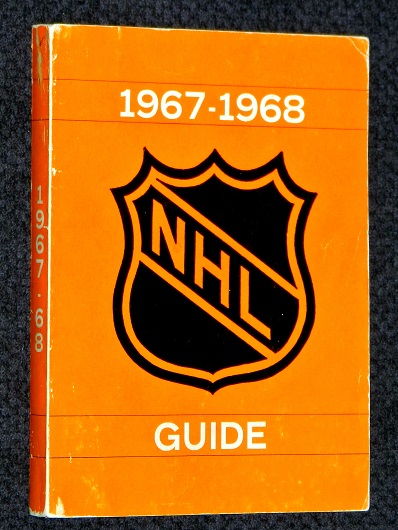
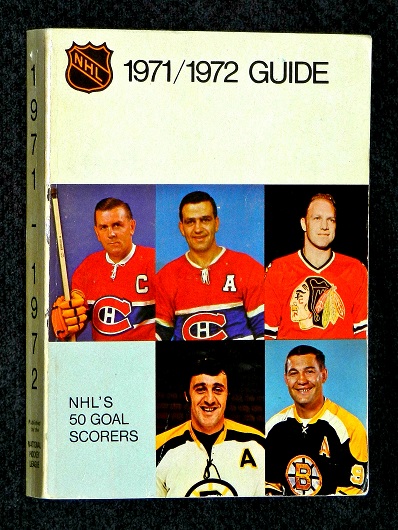
The official NHL Guide from that expansion season of 1967–68 (top–left) and from 1971–72 (right). At the time, as per the cover, Maurice Richard, Bernie Geoffrion, Bobby Hull, Phil Esposito and John Bucyk were the only players in league history to score 50 goals in a season. Today, a total of 87 players have reached the milestone. Wayne Gretzky still holds the single–season record of 92 goals (1981–82 with Edmonton). The final edition of the NHL Guide & Record Book was published in 2017–18.
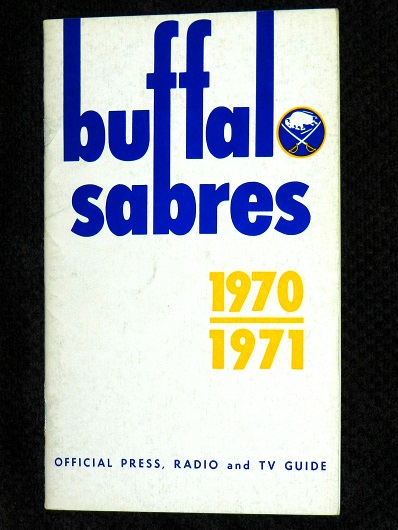
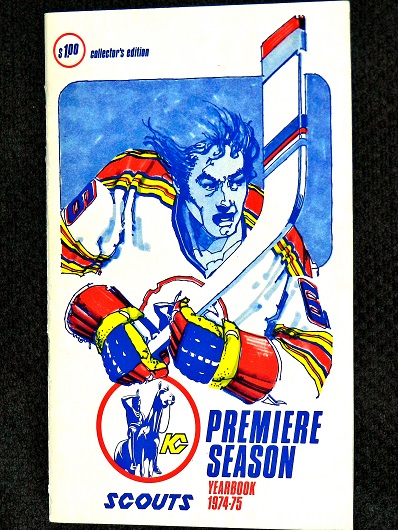
NHL media guides are also now extinct, as most teams stopped publishing them between 2009 and 2012 (the Maple Leafs kept going through last season). I have more than one thousand–such items in my collection, dating to 1960–61. Included, are the inaugural issues from the Buffalo Sabres (top–left) and Kansas City Scouts (right). The Scouts left Missouri after just two seasons and re–located in Denver as the Colorado Rockies. The franchise moved east and became the New Jersey Devils in 1982–83.
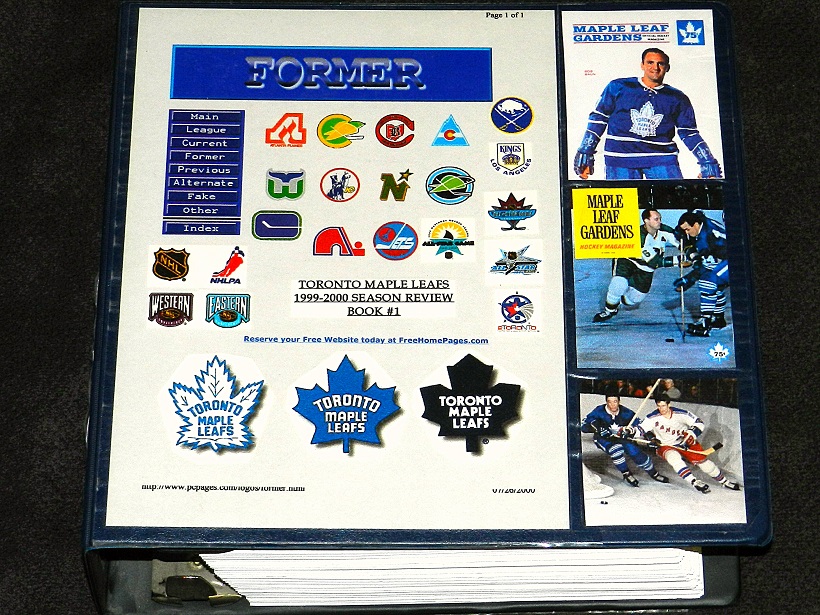
For no particular reason, in the summer of 2000, I created two enormous binders of information from the last NHL season of the millennium. Included were recaps and summaries from all Maple Leafs games — exhibition, regular season and playoffs. Also, a large section on just about every hockey logo I could find on the Internet 20 years ago (Junior, Minor Pro, NHL, Defunct Teams, WHA). I decorated the binders (Book 1, above) and went through six or seven ink cartridges for the color printer at my in–laws’ house in Los Angeles. You may recall that the Leafs (bottom–right) began the 2000’s with a particularly onerous display in Buffalo. The World Hockey Association (1972–79) logos from the binder are also below.
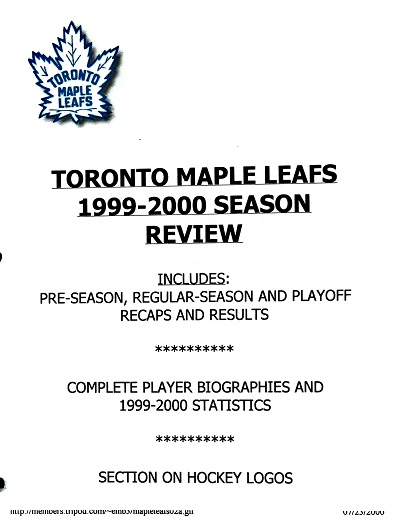
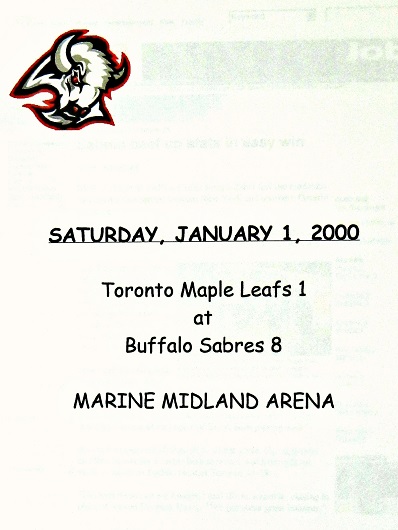
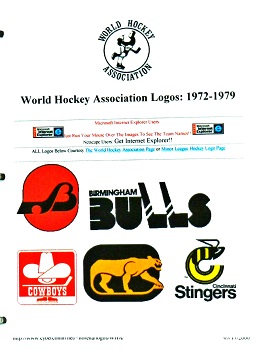
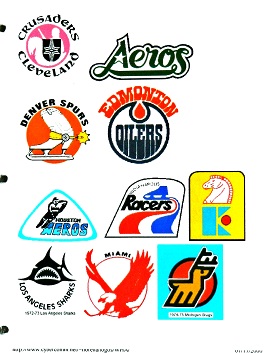
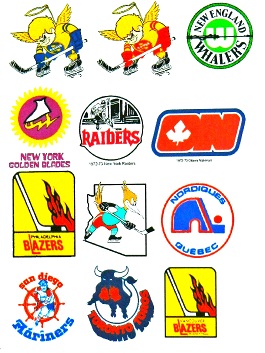
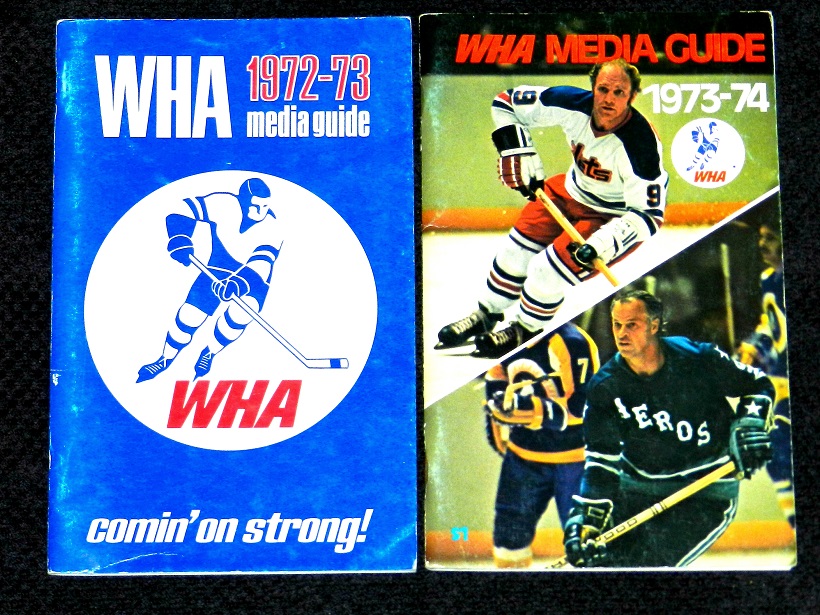
Speaking of the NHL’s old nemesis from the ’70’s, I have the official WHA Guide from all seven years of the league’s existence. Here are the first two: from 1972–73 and 1973–74. The cover of the latter Guide featured two of the greatest hockey players of all time — Bobby Hull (Winnipeg Jets) and Gordie Howe (Houston Aeros). Howe came out of retirement in ’73–74 at 45 years of age to play with his sons, Mark and Marty.
EMAIL: HOWARDLBERGER@GMAIL.COM

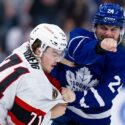
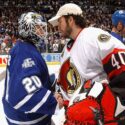






























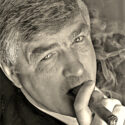
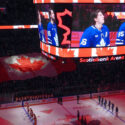

” The Leafs possess neither trait; they rely on acrobatic goaltending to accrue points.”
Howard, this is where I disagree with you and most of the media. I feel Andersen is by far the most overrated Leaf. This idea he “Carries” the team and is a Vezina and maybe Hart trophy candidate (You did not say this, some of the media do) is utter nonsense. He stunk the entire month of October and the last month has not been strong at all. His save % is outside the top 20 for NHL goaltenders. I guarantee is he doesn’t significantly play better and boost those numbers he won’t get a sniff in consideration for the Vezina.
The Leafs great offensive firepower boosts his win total. He is a “Solid” starter, built far from the elite superstar he is praised as. Superstar goalies don’t have rather avg numbers and 2-3 looong stretches in every season where they are just bad and hurt their team.
Auston Matthews is the team MVP. And unlike Andersen, he possesses the statistics and talent to be an elite star at his position.
Awesome..enjoy you sharing your great collection. I was a teenager when the Toros played at Varsity (what a treat to see legends up close) then at the Gardens..great time and memories